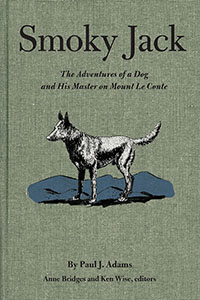Good Dog
With Smoky Jack, a lost classic of nature writing is finally published after ninety years
A full decade before Great Smoky Mountains National Park was chartered by the federal government, the Knoxville-based Great Smoky Mountains Conservation Association acquired a vast tract of land from a timber company. In 1925 they hired Paul Adams, a thin twenty-four-year-old known for his outdoor skills, to become the property’s caretaker and build a cabin near the summit of Mt. Le Conte to serve as a resting spot for hikers. Adams’s journals from the year he spent there became the basis of an unpublished manuscript he wrote late in life. Now, more than twenty years after his death, that manuscript has been edited by Ken Wise and Anne Bridges, directors of The Smoky Mountain Regional Project at The University of Tennessee Libraries, and published as Smoky Jack: The Adventures of a Dog and His Master on Mount Le Conte.
 As the title suggests, this story is not Adams’s alone—it belongs mostly to a talented German Shepherd, Cumberland Jack II of Edelweis, who came to be known as Smoky Jack. Adams had entered the University of Tennessee in 1923 but left for medical reasons. A doctor’s suggestion that time spent outdoors would speed his recovery soon had Adams hiking some of the most difficult terrain of East Tennessee. When he received the commission from the conservation association, Adams knew he would need a dog.
As the title suggests, this story is not Adams’s alone—it belongs mostly to a talented German Shepherd, Cumberland Jack II of Edelweis, who came to be known as Smoky Jack. Adams had entered the University of Tennessee in 1923 but left for medical reasons. A doctor’s suggestion that time spent outdoors would speed his recovery soon had Adams hiking some of the most difficult terrain of East Tennessee. When he received the commission from the conservation association, Adams knew he would need a dog.
“These were Knoxville businessmen who had never hiked up Mt. Le Conte,” editor Anne Bridges explained in a recent phone interview. “They had no idea how hard it would be to bring food and building supplies to the peak.” Despite the rugged terrain, according to Bridges, the conservation association had the unrealistic idea that Adams, who had been in the newspapers for hiking adventures he clearly enjoyed, could easily set up something like the small hotels springing up around Gatlinburg.
Smoky Jack was already something of a Knoxville legend before Adams set his sights on his future mountain companion. A highly trained police dog, Jack had tracked and assisted the capture of several notorious criminals for his master, a detective on the Knoxville police force. When the detective was killed “in a running gun battle,” Adams writes, a local trainer and friend began caring for the dog on behalf of the officer’s widow, who hoped to sell him. The widow wanted $500, the equivalent of about $6,800 today—an immense sum for a barely employed young man. She liked Adams, however, and could tell the dog liked him. Eventually she cut the price in half and allowed Adams to pay over time. The stage was set for grand adventure.
 And what an adventure it was. Together, man and dog battled blizzards, bears, unforgiving terrain, and even armed robbers. Adams made saddle packs for Jack and taught him to hike alone to a store in Gatlinburg, where the shopkeeper would read the note inside and fill an order for up to twenty pounds of supplies. Jack routinely carried these provisions up the mountain alone, fording streams, climbing fallen logs, and skirting waterfalls. He was able to track and rescue lost hikers—including, on one occasion, his own master, whom newspapers across the country had pronounced lost and presumed dead after attempting to forge a new trail through Huggins Hell.
And what an adventure it was. Together, man and dog battled blizzards, bears, unforgiving terrain, and even armed robbers. Adams made saddle packs for Jack and taught him to hike alone to a store in Gatlinburg, where the shopkeeper would read the note inside and fill an order for up to twenty pounds of supplies. Jack routinely carried these provisions up the mountain alone, fording streams, climbing fallen logs, and skirting waterfalls. He was able to track and rescue lost hikers—including, on one occasion, his own master, whom newspapers across the country had pronounced lost and presumed dead after attempting to forge a new trail through Huggins Hell.
Adams portrays Jack as a real-life Rin-Tin-Tin, White Fang, and then some. If not for the historic photos Bridges and Wise provide, as well as ample footnotes confirming various contemporary news accounts of the dog’s deeds, a reader might assume that Smoky Jack is as much a fictional creation as any found in a Jack London novel. Why, then, has his story remained obscure for ninety years?
“Adams was not the most gifted writer,” Bridges explained. He did not always place events in context, and he wrote in a simple prose style that did not always reflect his vast knowledge of mountain flora and fauna. When the commission suddenly dismissed him from his position without explanation in 1926, he used that knowledge to open a nursery specializing in native plants, and there both Jack and Adams lived out their remaining years. So Smoky Jack was, in essence, the reminiscences of a retired nursery operator when three different publishers rejected it for “organizational problems,” as Bridges and Wise write in their introduction.
When The Smoky Mountain Regional Project received a gift of the manuscript and boxes of historic photographs that had belonged to Adams, however, they recognized that a powerful tale lay hidden within it. “It was like finding a classic boys’ adventure story,” Bridges said. But it took her and Wise several years to tease the story out—in part because as historians they were committed to confirming the facts of Adams’s account.
They were also determined for the book to remain as true as possible to Adams’s original language and structure. The result of their careful editing is a prose style that remains simple but has achieved the nobility of great American naturalism—at times the account reads like Stephen Crane or young Ernest Hemingway. Here is Adams describing an attempt to catch up with Jack, who has mistakenly headed down the mountain because of the way Adams had tied his saddlebags that morning:
At the first creek crossing, I saw his fresh footprints in the clay bank and knew that he was ahead of me. I hurried on. At several other creek crossings, I saw his fresh footprints. When I came to the top of Rainbow Falls, I did not go by trail across the stream but hurried to the brink of the precipice. There, far below, I saw Jack headed downhill. It took several loud calls before he heard my voice above the roar of the falls. He stopped, turned around, and looked up at me. I knew he had seen me because he wagged his tail.
Dog-lovers, readers with an interest in the history of one of the country’s best-known national parks, and anyone who craves a classic adventure yarn will be wagging their metaphorical tails over Smoky Jack.

Michael Ray Taylor teaches journalism at Henderson State University in Arkadelphia, Arkansas. He is the author of several books of nonfiction and coauthor of a recent textbook, Creating Comics as Journalism, Memoir and Nonfiction.


